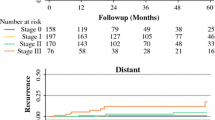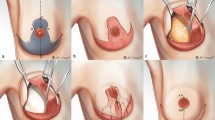Abstract
Background
Skin-sparing mastectomy (SSM) and nipple-sparing mastectomy (NSM) are the standard techniques for achieving a cosmetic outcome, but necrosis of a cutaneous flap including the nipple–areolar complex (NAC) is a serious complication. To analyze the risk factors for skin flap necrosis, we retrospectively evaluated a clinical database of breast cancer patients treated with mastectomy followed by immediate breast reconstruction.
Methods
Four hundred and twelve cases were consecutively recorded between 2006 and 2016. Body weight (BW), body mass index (BMI), distance from NAC to referent tumor, distance from overlying skin to the tumor and weight of breast resection (WBR) as measured in the operating theater were included in the statistical analysis.
Results
NSM, SSM and total mastectomy were performed in 123 (30%), 96 (23%) and 193 cases (47%), respectively. A tissue expander was used in 379 cases (92%), a silicone implant in 8 (2%) and autologous breast reconstruction in 25 (6%). Skin flap necrosis was found in 7% of all cases and NAC necrosis in 13% of NSM cases. In a univariate analysis, BW, NSM and WBR were risk factors for skin flap necrosis, and BW, BMI and WBR were risk factors for NAC necrosis. In a multivariate analysis, NSM and WBR remained significant risk factors for skin flap necrosis, and WBR was a significant risk factor for NAC necrosis.
Conclusions
WBR is an important risk factor for skin flap necrosis. Especially, NAC necrosis should be considered for patients with large-volume breasts who undergo NSM and immediate breast reconstruction.




Similar content being viewed by others
References
Cancer statistics in Japan-2014. http://ganjoho.jp/reg_stat/statistics/brochure/backnumber/2014_jp.html (in Japanese)
Fisher B, Anderson S, Bryant J et al (2002) Twenty-year follow-up of a randomized trial comparing total mastectomy, lumpectomy, and lumpectomy plus irradiation for the treatment of invasive breast cancer. N Engl J Med 347:1233–1241
Veronesi U, Cascinelli N, Mariani L et al (2002) Twenty-year follow-up of a randomized study comparing breast-conserving surgery with radical mastectomy for early breast cancer. N Engl J Med 347:1227–1232
Spear SL, Hannan CM, Willey SC et al (2009) Nipple-sparing mastectomy. Plast Reconstr Surg 123:1665–1673
Komorowski AL, Zanini V, Regolo L et al (2006) Necrotic complications after nipple- and areola-sparing mastectomy. World J Surg 30:1410–1413. https://doi.org/10.1007/s00268-005-0650-4
Shimo A, Tsugawa K, Tsuchiya S et al (2016) Oncologic outcomes and technical considerations of nipple-sparing mastectomies in breast cancer: experience of 425 cases from a single institution. Breast Cancer 23:851–860
Gerber B, Krause A, Dieterich M et al (2009) The oncological safety of skin sparing mastectomy with conservation of the nipple-areola complex and autologous reconstruction: an extended follow-up study. Ann Surg 249:461–468
Kneubil MC, Lohsiriwat V, Curigliano G et al (2012) Risk of locoregional recurrence in patients with false-negative frozen section or close margins of retroareolar specimen in nipple-sparing mastectomy. Ann Surg Oncol 9:4117–4123
Lanitis S, Tekkis PP, Sgourakis G et al (2010) Comparison of skin-sparing mastectomy versus non-skin-sparing mastectomy for breast cancer: a meta-analysis of observational studies. Ann Surg 251:632–639
Ueda S, Tamaki Y, Yano K et al (2008) Cosmetic outcome and patient satisfaction after skin-sparing mastectomy for breast cancer with immediate reconstruction of the breast. Surgery 143:414–425
Sacchini V, Pinotti JA, Barros AC et al (2006) Nipple-sparing mastectomy for breast cancer and risk reduction: oncologic or technical problem? J Am Coll Surg 203:704–714
Dent BL, Millwe JA, Eden DJ et al (2017) Tumor-to-nipple distance as a predictor of nipple involvement: expanding the inclusion criteria for nipple-sparing mastectomy. Plast Reconstr Surg 140:1e–8e
Ryu JM, Nam SJ, Kim SW et al (2016) Feasibility of nipple-sparing mastectomy with immediate breast reconstruction in breast cancer patients with tumor-nipple distance less than 2.0 cm. World J Surg 40:2028–2035.https://doi.org/10.1007/s00268-016-3487-0
Lim W, Ko BS, Kim HJ et al (2010) Oncological safety of skin sparing mastectomy followed by immediate reconstruction for locally advanced breast cancer. J Surg Oncol 102:39–42
Matsen CB, Mehrara B, Eaton A et al (2016) Skin flap necrosis after mastectomy with reconstruction: a prospective study. Ann Surg Oncol 23:257–264
Crowe JP Jr, Kim JA, Yetman R et al (2004) Nipple-sparing mastectomy: technique and results of 54 procedures. Arch Surg 139:148–150
Davies K, Allan L, Roblin P et al (2011) Factors affecting post-operative complications following skin sparing mastectomy with immediate breast reconstruction. Breast 20:21–25
Lohsiriwat V, Rotmensz N, Botteri E et al (2013) Do clinicopathological features of the cancer patient relate with nipple areolar complex necrosis in nipple-sparing mastectomy? Ann Surg Oncol 20:990–996
Cho JW, Toon ES, You HJ et al (2015) Nipple-areola complex necrosis after nipple-sparing mastectomy with immediate autologous breast reconstruction. Arch Plast Surg 42:601–607
Algaithy ZK, Petit JY, Lohsiriwat V et al (2012) Nipple sparing mastectomy: can we predict the factors predisposing to necrosis? Eur J Surg Oncol 38:125–129
Frey JD, Alperoxich M, Levine JP et al (2017) Does smoking history confer a higher risk for reconstructive complications in nipple-sparing mastectomy? Breast J 23:415–420
Garwood ER, Moore D, Ewing C et al (2009) Total skin-sparing mastectomy: complications and local recurrence rates in 2 cohorts of patients. Ann Surg 249:26–32
Robertson SA, Jeevaratnam JA, Agrawal A et al (2017) Mastectomy skin flap necrosis: challenges and solutions. Breast Cancer (Dove Med Press) 13:141–152
Wolff AC, Hammond ME, Schwartz JN et al (2007) American Society of Clinical Oncology/College of American Pathologists guideline recommendations for human epidermal growth factor receptor 2 testing in breast cancer. J Clin Oncol 25:118–145
Ponzone R, Maggiorotto F, Carabalona S et al (2015) MRI and intraoperative pathology to predict nipple-areola complex (NAC) involvement in patients undergoing NAC-sparing mastectomy. Eur J Cancer 51:1882–1889
Diep GK, Hui JY, Marmor S et al (2016) Postmastectomy reconstruction outcomes after intraoperative evaluation with indocyanine green angiography versus clinical assessment. Ann Surg Oncol 12:4080–4085
Acknowledgements
The first author would like to thank Dr. Ouellette Tomoyo, Director of Kaneko Clinic, for her clinical advice.
Author information
Authors and Affiliations
Corresponding author
Ethics declarations
Conflict of interest
All authors declare that they have no conflict of interest.
Rights and permissions
About this article
Cite this article
Ito, H., Ueno, T., Suga, H. et al. Risk Factors for Skin Flap Necrosis in Breast Cancer Patients Treated with Mastectomy Followed by Immediate Breast Reconstruction. World J Surg 43, 846–852 (2019). https://doi.org/10.1007/s00268-018-4852-y
Published:
Issue Date:
DOI: https://doi.org/10.1007/s00268-018-4852-y




